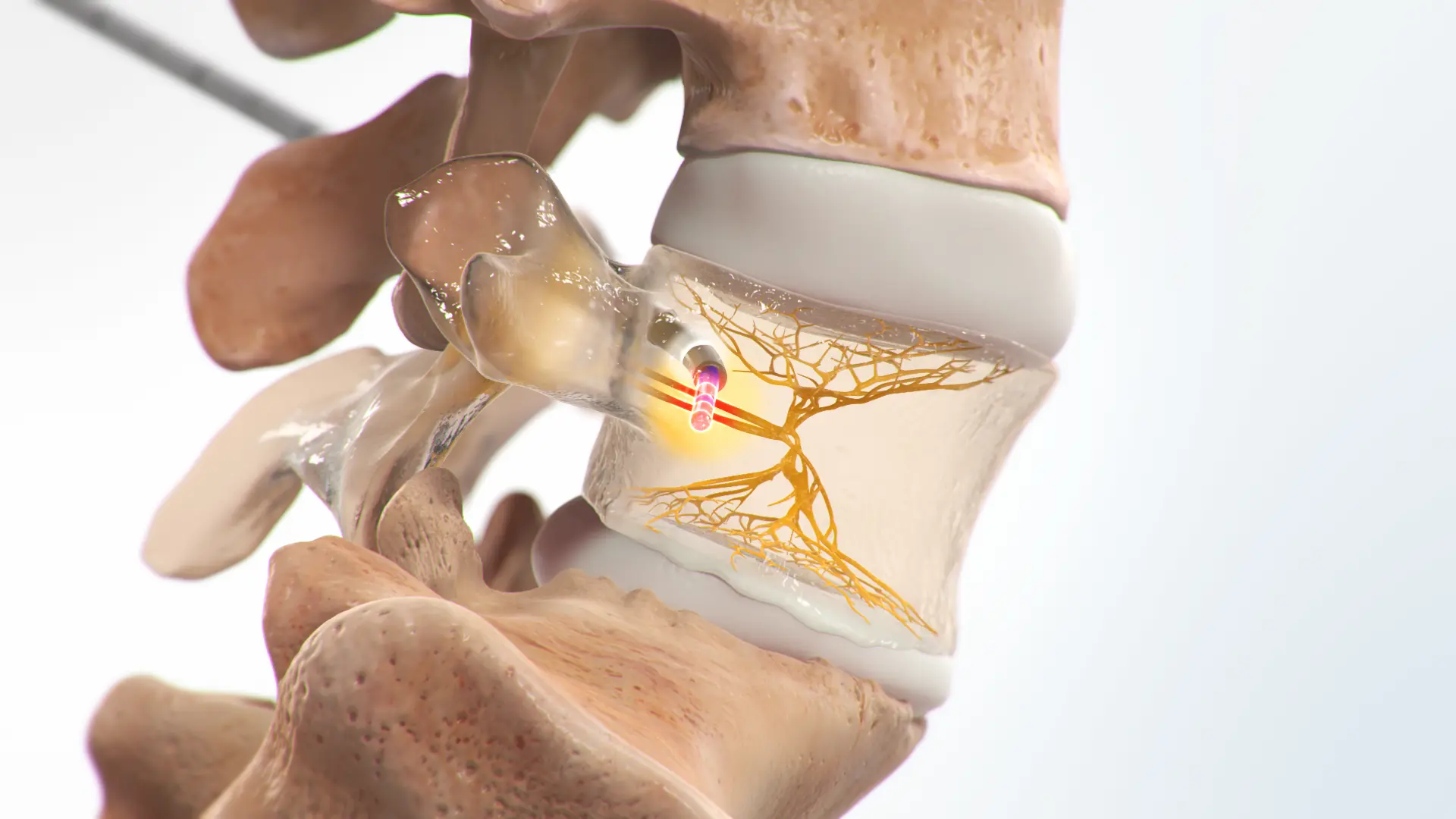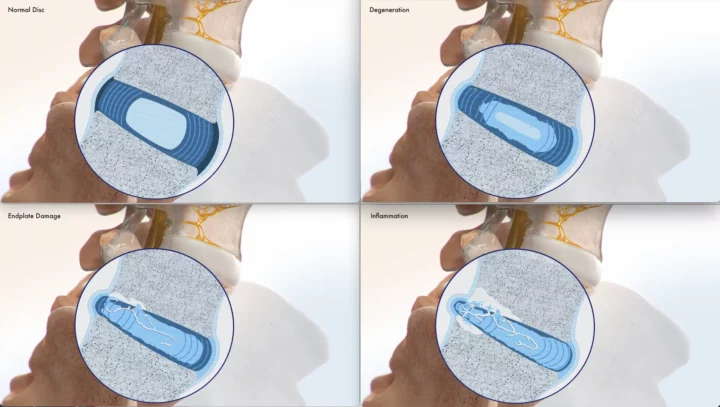Intracept Procedure
Are you or a loved one suffering from chronic lower back pain? Do you find it difficult to enjoy daily activities due to this constant discomfort? MD Pain in Denver Metro offers an innovative solution to alleviate your suffering and help you regain your quality of life through the Intracept Procedure.
The Intracept Procedure, also known as basivertebral nerve ablation, is a minimally invasive outpatient intervention that specifically targets a nerve located within the spinal vertebrae. This treatment is specifically indicated for individuals who have endured chronic low back pain for a minimum of six months, have explored conservative treatment options, and whose MRI scans reveal evidence of Modic changes. Modic changes signify damage at the vertebral endplates, which has led to persistent inflammation. These changes are a common finding among lower back pain sufferers and can be readily identified through a standard MRI.
The effectiveness of the Intracept procedure is supported by multiple Randomized Control Trials, underscoring its ability to provide sustained relief from axial back pain for a duration exceeding five years. Clinical trials have demonstrated impressive results, with patients commonly reporting a remarkable reduction in pain ranging from 60% to 80%.
The Intracept procedure is conducted in a controlled outpatient setting, either within a surgery center or a hospital environment. During the procedure, a skilled MD Pain provider will carefully insert a specialized probe into the vertebrae, utilizing radiofrequency energy in the form of heat to incapacitate the nerve, preventing it from transmitting painful signals. The entire Intracept Procedure typically lasts between 60 to 90 minutes and does not involve implanting any devices or structural modifications to the spine. Patients undergoing this procedure can benefit from the choice of a general anesthetic or sedation, tailored to meet their individual needs and preferences.
Procedure Overview
The Intracept Procedure is a minimally invasive, groundbreaking treatment specifically designed to target the source of chronic low back pain – the basivertebral nerve. Unlike traditional treatments that focus on managing symptoms, the Intracept Procedure gets to the root of the problem, providing long-lasting relief.
Here's how the Intracept Procedure works:
- Diagnosis: Our skilled medical team will perform a comprehensive evaluation to determine if you are a suitable candidate for the Intracept Procedure. This evaluation typically involves imaging studies and a thorough discussion of your medical history.
- Treatment Day: Once you are deemed a candidate for the procedure, it will be scheduled at your convenience. The Intracept Procedure is typically performed on an outpatient basis. You will receive local anesthesia to ensure your comfort during the procedure.
- Thermal Ablation: A specialized probe is carefully inserted into the vertebral body of the problematic level. This probe delivers thermal energy to the basivertebral nerve, effectively disrupting its function. This step is crucial in eliminating the source of your pain.
- Recovery: After the procedure, patients are observed for a brief period to ensure their safety and return home the same day. You will be provided with clear post-procedure instructions to optimize your recovery.
After Care Information
Recovery from the Intracept Procedure is generally swift and accompanied by minimal discomfort. However, it is essential to follow these aftercare instructions to ensure the best possible outcome:
- Rest: While it's important to stay active to aid the healing process, it's equally crucial to get ample rest during the initial recovery period. Avoid strenuous activities and lifting heavy objects for at least the first few days following the procedure.
- Pain Management: Some discomfort after the procedure is normal. Your healthcare provider will prescribe pain medications if necessary. Make sure to take them as directed.
- Follow-up Appointments: Attend all scheduled follow-up appointments with your healthcare provider. These appointments are crucial for monitoring your progress and making any necessary adjustments to your treatment plan.
- Physical Therapy: In some cases, physical therapy may be recommended to strengthen your back and improve your overall function. Follow your physical therapist's recommendations diligently.
- Lifestyle Adjustments: Pay attention to your posture, ergonomics, and lifting techniques to prevent recurrence of back pain. Your healthcare provider may offer guidance on lifestyle adjustments to reduce the risk of future problems.
At MD Pain, our mission is to help you regain your quality of life and put an end to chronic low back pain. Our team of experienced professionals is committed to providing you with the highest standard of care and expertise in pain management. If you're suffering from this debilitating condition, consider the Intracept Procedure. Reach out to our dedicated team today to schedule a consultation and take the first step towards a pain-free future.
Frequently Asked Questions
Candidates for Intracept must meet three criteria: 1.) Chronic lower back pain for at least six months. 2.) Insufficient results from conservative measures like chiropractic care, yoga, medication, injections, and physical therapy. 3.) Modic changes in the vertebral endplates which are visible on MRI and represent inflammation and pain.
The average time for The Intracept Procedures is about 1 hour and 20 minutes. The procedure is typically done in an operating room in the hospital or an Ambulatory Surgery Center, with the patient going home later the same day.
Intracept is a minimally invasive procedure that targets the basivertebral nerve for the relief of chronic vertebrogenic low back pain.
- Infection
- Increased back pain
- Bleeding
- Nerve damage
Vertebrogenic pain is a distinct type of chronic low back pain caused by damage to vertebral endplates, the tissue that covers the top and the bottom of each vertebral body and separates it from the disc. Disc degeneration, and the wear and tear that occurs with everyday living, produces stresses on the endplates that damage them, leading to inflammation and vertebrogenic pain. The basivertebral nerve (BVN), found within the vertebrae, carries pain signals from the inflamed endplates to the brain.
The disc and endplate are both part of the anterior spinal column and produce similar low back pain symptoms. However, endplate pain is associated with distinctive changes on routine MRI called Modic changes. Patients who find relief from the Intracept Procedure often describe pain in the middle of their low back that is made worse by physical activity, prolonged sitting, and
bending forward or with bending and lifting.1
1 Koreckij T, Kreiner S, Khalil JG, Smuck M, Markman J, Garfin S. Prospective, randomized, multicenter study of intraosseous basivertebral nerve ablation for the treatment of chronic low back pain: 24-month treatment arm results. NASSJ. Published online October 26, 2021. DOI: https://doi.org/10.1016/j.xnsj.2021.100089.
The basivertebral nerve (BVN) enters the bone at the back of the vertebral body (the bones in your spine) and “branches” to the endplates (that are located at the top and the bottom of each vertebral body). When endplates are damaged, these nerve endings increase in number and “pick up” pain signals that are then sent to the brain through the BVN. The Intracept® Procedure relieves vertebrogenic pain by heating the basivertebral nerve (BVN) with a radiofrequency probe to stop it from sending pain signals to the brain.
The Intracept Procedure is a minimally invasive, implant free procedure that preserves the overall structure of the spine. The Intracept Procedure is a same-day, outpatient procedure. Patients are under anesthesia, and the procedure generally lasts an hour. The procedure is FDA-cleared and is proven in multiple studies to be safe, effective, and durable.2,3
2 Fischgrund J, Rhyne A, Macadaeg K, et al. Long-term outcomes following intraosseous basivertebral nerve ablation for the treatment of chronic low back pain: 5-year treatment arm results from a prospective randomized double-blind sham-controlled multi-center study. Eur Spine J. 2020;29(8):1925-34. doi.org/10.1007/s00586-020-06448-x
3 Relievant data on file as of January 2023.
Clinical evidence demonstrates the majority of patients experience significant improvements in function and pain 3-months post procedure that are sustained more than 5 years after a single treatment.2
2 Fischgrund J, Rhyne A, Macadaeg K, et al. Long-term outcomes following intraosseous basivertebral nerve ablation for the treatment of chronic low back pain: 5-year treatment arm results from a prospective randomized double-blind sham-controlled multi-center study. Eur Spine J. 2020;29(8):1925-34. doi.org/10.1007/s00586-020-06448-x
The Intracept® Procedure is indicated for patients who have had:
Chronic low back pain for at least six months,
Who have tried conservative care for at least six months, and
Whose MRI shows features consistent with Modic changes – indicating damage at the
vertebral endplates has led to inflammation.
The Intracept Procedure, as with any procedure, has risks that should be discussed between
the patient and medical provider.


